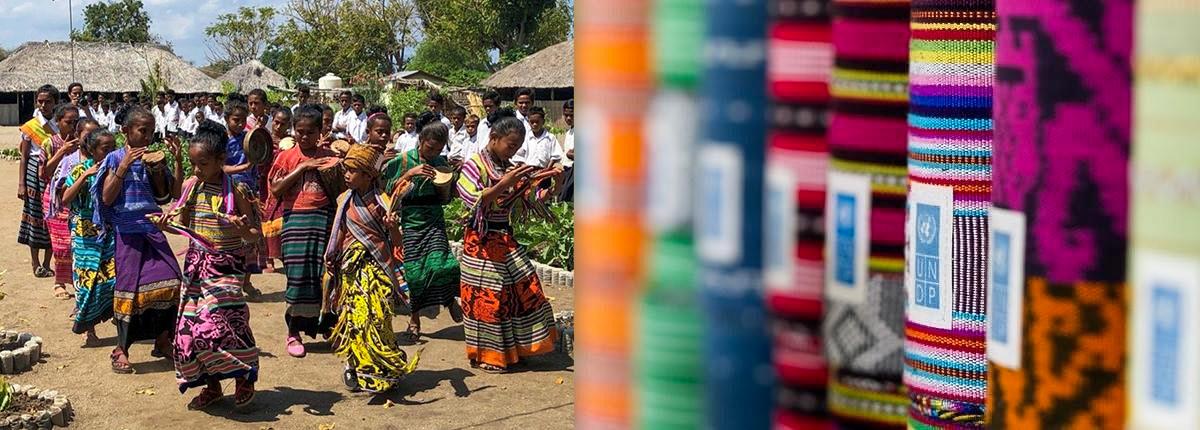We are producing significantly more garments annually than just a few decades ago – prior to COVID-19 it was estimated at 80-100 billion pieces per year. How does production on such a scale affect cultural identity and heritage? For World Day for Cultural Diversity for Dialogue and Development, we looked at the impact of mass production on heritage and traditional crafts, particularly textiles.
Global industrialization and price competition in local markets have been cited as challenges to maintaining textile traditions, and importantly, related livelihoods. With an abundance of imported materials and clothing, local designers are left with limited space in the market. This is the case in Timor-Leste, where imported fabrics are easily available and at lower prices, putting pressure on the local production of handwoven tais.
Timor-Leste is one of the youngest countries in the world. After years of war, it regained its independence in 1999, and with it the challenge of reinvigorating its economy and cultural identity. For centuries, tais have been used for ceremonial adornment, decoration, and clothing. Designs vary by region, through traditional patterns handed down from generation to generation, and use of natural dyes available in the area. Tais share history and tell stories.
The possibility of a bland fashion future starts to come to mind, where we are all dressed the same, losing our cultural expression. And worse, where this homogeny came at the cost of cultural heritage and the development of local economies. But there is indeed market potential for culturally-inspired pieces. As noted by Simone Cipriani of the Ethical Fashion Initiative, “Mass production always presents a risk of identity loss. However, I remain convinced that productions linked to cultural identities happening where these identities are developed, benefit local society with work and income.”
To do this, it will be necessary to reinvent the concept of tais, maintaining its cultural origin but giving it new uses, aimed for instance at a growing tourism sector in Timor-Leste and turning tais into a means for local and sustainable development.
Some companies have already successfully linked economic potential with the innovative promotion of cultural heritage. Things and Stories showcases, brands and markets more than 400 selected products, creating the missing link between Timor-Leste's handcraft producers and niche markets across the world. Their collection includes traditional tais, as well as items which incorporate tais, such as handbags and accessories, home décor and other everyday items such as notebooks, gifts and souvenirs. While their work has benefited 56 producer groups, representing over 700 artisans, per owner João Ferro, “Things and Stories does not exist to alleviate poverty. We want to do much more than that, including empowering women and celebrating cultural heritage. Our strategy is focused on collaborative work with our artisans to create high-quality, added value products, all handmade, guided by a strong vision of a vibrant and innovative handcraft sector for Timor-Leste.”
More support is needed to expand these opportunities. As Juliana Tebi of the Feto Fitun Fronteira weavers’ group says, “Our big challenge concerns marketing. There are more and more competitors in the market, and we need training to be innovative, facilities to get our raw material and orientation to manage a bank account."
Through the Special Administrative Region and the Special Zones for Social Market Economy (RAEOA-ZEESM TL), UNDP is working with tais weavers’ groups to develop their businesses, while promoting inclusive practices for women and girls, as well as raising cultural awareness to attract tourism. This includes training in weaving to increase the quality of their products, to both preserve traditional patterns as well as to create new models that allow them to integrate tais into modern clothing and items.
While global production has increased, the time clothing is worn has fallen by around 40 percent. Donation is often presented as a solution to overproduction. And the secondhand market is indeed important. But the scale at which clothing is produced, coupled with the shorter time we keep our clothes, has resulted in a flood of imported secondhand clothing into countries – presenting similar challenges by undermining domestic design and local industries. It has become such a problem that a number of countries have tried to ban it.
In the meantime, small businesses will continue to face challenges to being competitive, but there are areas where better planning, support to businesses and complementary measures can fill the gaps. As Mr. Cipriani explains, these include ensuring that product development and market projections take into account diseconomies such as poor transport, calculating prices in order to have good margins that finance working capital and investments, skills development in management and accounting, and access to credit at acceptable rates.
Ultimately, it may be innovation and a bit of business savvy that will dictate how successful we are at preserving cultural heritage in a saturated fashion market. But perhaps more concerning is that such effort is needed to protect important things. As consumers, we can support local industries through our choices. Maybe even opting for a bit of flair in our wardrobe when we can – choosing expression over more of the same. From the industry side, as Mr. Cipriani states, “We need to, collectively, strive to be better informed and support a new generation of consumers who are more contentious in their purchasing behaviors. We need to guide this industry into becoming fairer and to measure their social and environmental footprint in a quantitative and transparent manner.”

 Locations
Locations
